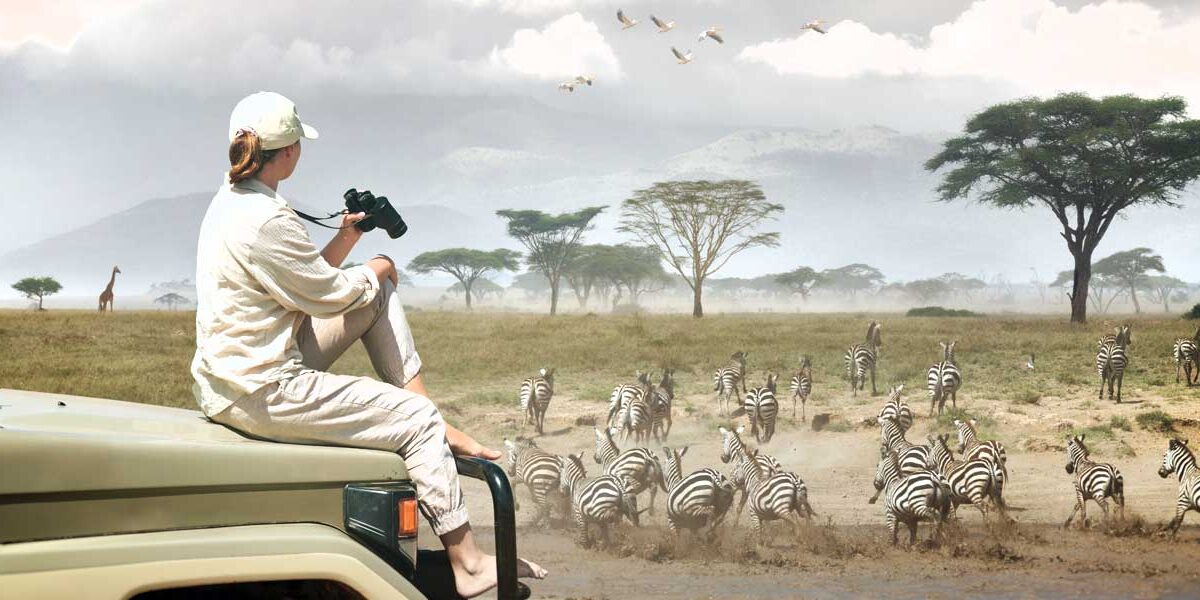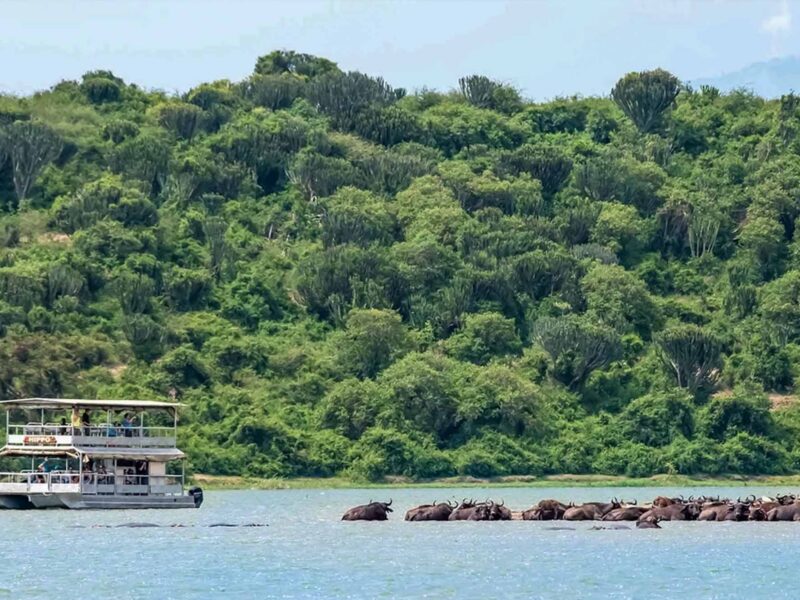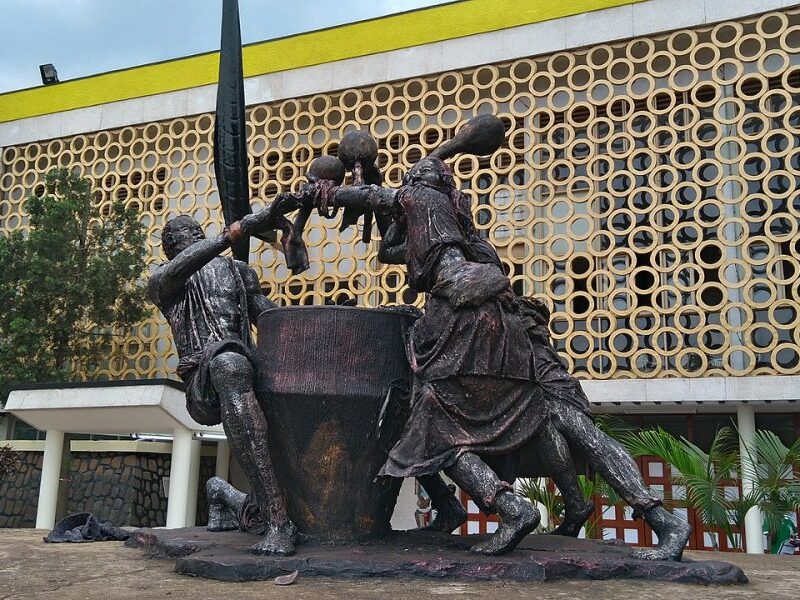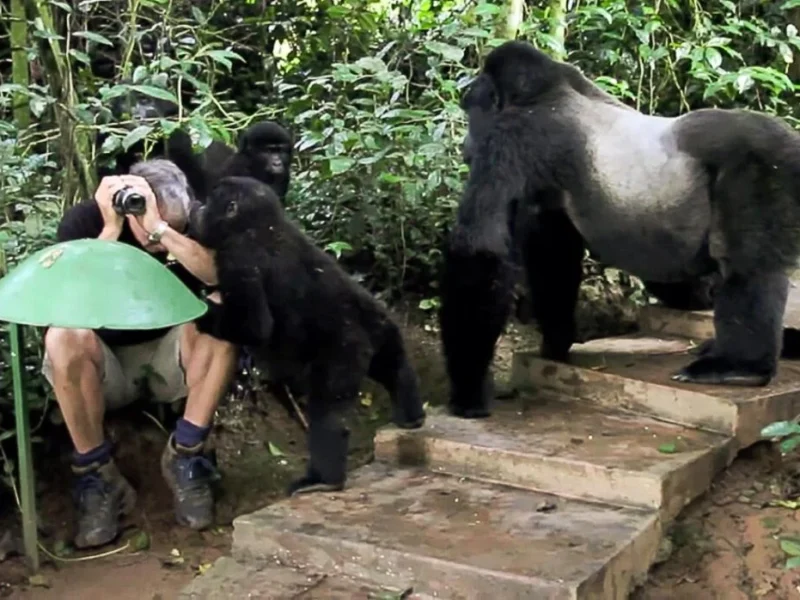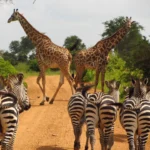
The Great Migration: Nature’s Greatest Wildlife Spectacle
September 17, 2025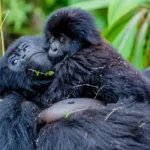
Discovering Silverback Gorillas in Rwanda and Uganda: East Africa’s Ultimate Wildlife Encounter
September 22, 2025Queen Elizabeth National Park: The Majestic Crown Jewel of Uganda’s Wilderness
Nestled in the heart of the Albertine Rift Valley in southwestern Uganda, Queen Elizabeth National Park (QENP) is an ecological gem and a cornerstone of Uganda’s tourism industry. Spanning approximately 1,978 square kilometers, the park is celebrated not only for its breathtaking scenery and wildlife diversity, but also for its accessibility, historical significance, and cultural richness. As one of the most visited parks in Uganda and a recognized UNESCO Man and Biosphere Reserve, Queen Elizabeth National Park stands as a shining example of East Africa’s natural heritage.
Historical Background: A Royal Legacy
Originally established in 1952 as Kazinga National Park, the protected area was renamed two years later to honor a visit by Queen Elizabeth II. This royal endorsement elevated the park’s international profile and marked it as one of Africa’s prestigious safari destinations. The park has since played a vital role in Uganda’s conservation history and tourism development, despite challenges such as poaching, civil unrest, and human encroachment in past decades.
Geography and Ecosystems: Nature’s Grand Design
QENP stretches across the districts of Kasese, Rubirizi, Rukungiri, and Kamwenge, bordered by the Rwenzori Mountains to the north and the Ishasha River (forming part of the DRC border) to the south. The park lies between two significant lakes Lake George and Lake Edward which are linked by the famed Kazinga Channel, a 32-kilometer-long natural waterway that teems with aquatic life.
Key Ecosystems:
1. Savannah Grasslands – Ideal for game drives and home to lions, buffaloes, and Uganda kobs.
2. Tropical Rainforests – Found in Kyambura Gorge and Maramagambo Forest, rich in primates and rare bird species.
3. Wetlands and Lakes – Crucial breeding grounds for birds, hippos, and crocodiles.
4. Crater Lakes and Volcanic Cones – Formed by ancient volcanic activity, offering unique landscapes and habitats.
This diverse topography supports a mosaic of habitats, creating one of the most biologically rich areas in all of Africa.
Biodiversity: A Wildlife Paradise
Queen Elizabeth National Park is often described as a “melting pot of African wildlife” due to its extraordinary biodiversity.
Mammals:
95+ species, including:
African elephants
Buffaloes
Lions, including the rare tree-climbing lions of Ishasha
Leopards
Hippos (especially dense in the Kazinga Channel)
Warthogs, hyenas, waterbucks, bushbucks, giant forest hogs
Chimpanzees in Kyambura Gorge
Birds:
With over 600 bird species, QENP is a birdwatcher’s dream. It is one of Africa’s best birding destinations.
Notable species:
Shoebill stork
African fish eagle
Flamingos at crater lakes like Katwe and Bunyampaka
Papyrus gonolek
Black bee-eaters
Various kingfishers, pelicans, hornbills, and weavers
Reptiles and Aquatic Life:
Nile crocodiles
Monitor lizards
Numerous fish species, especially tilapia and Nile perch
Top Attractions in Queen Elizabeth National Park
1. Kazinga Channel Boat Cruise
This is one of the signature experiences in the park. A boat safari along the Kazinga Channel offers unparalleled close-ups of hippos (arguably the highest density in Africa), crocodiles, elephants, and a spectacular variety of birds.
Best Time: Late afternoon (for golden light and more animal activity)
2. Game Drives in Kasenyi Plains and Ishasha Sector
Kasenyi is ideal for spotting Uganda kob, lions, buffaloes, and large herds of elephants.
Ishasha Sector (southern part of the park) is famous for its tree-climbing lions, which lounge in fig trees a rare behavior seen in only two places globally.
3. Kyambura Gorge Chimpanzee Tracking
Nicknamed the “Valley of Apes”, Kyambura Gorge is a lush, sunken tropical rainforest where visitors can track habituated chimpanzees, as well as see colobus monkeys, red-tailed monkeys, and abundant birds.
4. Crater Lakes Exploration
QENP is dotted with over 10 explosion craters, some filled with water, others dry but scenic. The Katwe Crater Drive offers panoramic views of the Western Rift Valley and Lake Edward.
Salt mining at Lake Katwe is also a unique cultural attraction, where visitors learn about traditional salt extraction techniques.
5. Maramagambo Forest Nature Walks
This forest is home to:
Bats and pythons in “Bat Cave”
Forest elephants
Birds like the forest flycatcher, greenbul, and sunbirds
Tranquil trails for guided nature walks
6. Cultural Encounters
Local communities around the park offer:
Music and dance performances
Village tours
Craft-making experiences
Traditional storytelling
This enriches the safari experience and supports community-based tourism.
Conservation and Sustainability
QENP is designated as a UNESCO Biosphere Reserve, highlighting its ecological value and the balance between conservation and human development.
Key Conservation Initiatives:
Anti-poaching patrols and community rangers
Habitat restoration projects
Human-wildlife conflict mitigation, including fencing and buffer zones
Eco-tourism and education programs in local schools
Transboundary cooperation with Virunga National Park in DRC for species like elephants and hippos
Despite conservation efforts, the park faces challenges such as:
Encroachment and land use pressure
Poaching (though significantly reduced)
Climate change effects on seasonal water availability
Why Queen Elizabeth National Park Is Unique in East Africa
High biodiversity in a relatively small area
Rare species, including tree-climbing lions and the elusive shoebill
Varied terrain: no other park in East Africa combines lakes, craters, rainforests, savannah, and wetlands so seamlessly
Accessibility: only 5-6 hours by road from Kampala; easily combined with other attractions like Bwindi Impenetrable Forest, Rwenzori Mountains, and Kibale National Park
Birding hotspot: over 600 species in a single park is unmatched regionally
Cultural integration: tourism that involves and benefits surrounding communities
Travel Information and Tips
Getting There:
By road: \~410 km from Kampala (6-7 hours)
By air: Charter flights from Entebbe or Kajjansi to Mweya Airstrip or Kasese Airport
Best Time to Visit:
Dry Seasons: June–September and December–February for easier wildlife viewing.
Wet Seasons: March–May and October–November—lush landscapes, migratory birds, and fewer crowds.
Accommodations:
Luxury: Mweya Safari Lodge, Kyambura Gorge Lodge
Mid-range: Enganzi Lodge, Park View Safari Lodge
Budget: Bush Lodge, Kazinga Channel View Resort, campsites
What to Pack:
Lightweight clothing, insect repellent, binoculars, sunscreen, camera with zoom lens, hiking boots (for Kyambura), warm layers (mornings can be cool)
The Soul of Uganda’s Safari Experience
Queen Elizabeth National Park offers one of the most comprehensive safari experiences in East Africa. From predator sightings and chimpanzee treks to crater hikes and cultural encounters, the park is a multi-sensory journey into the wild heart of Uganda. It’s a place where every sunrise brings a new discovery and every corner holds the promise of nature’s majesty.
Whether you’re a first-time visitor to Africa or a seasoned wildlife enthusiast, QENP promises not just memories, but moments of awe and reverence. It’s not just a national park it’s Uganda’s natural crown jewel.

